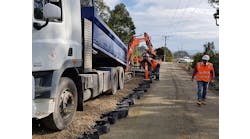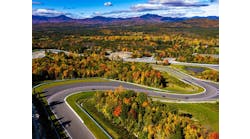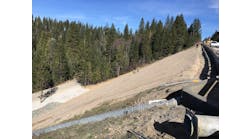Pennzoil has developed and patented a unique product that has proven effective in stabilizing erosion problems that sometimes occur during road and bridge construction projects. PennzSuppress EC is a unique soil binder that prevents erosion on sloping embankments during critical soil stabilization and turf establishment periods?without the need for mulch.
The environmentally safe agent eliminates wind and water erosion problems on steep embankments bordering highway overpasses and bridges, roads, airport runways and storm-water channels. It performs in demanding weather conditions to stabilize the soil and prevent erosion from occurring.
PennzSuppress EC evolved from PennzSuppress D, Pennzoil?s dust suppressant and soil stabilizer. It first earned industry respect at a $2.5 million landfill project in Texas.
Landfill design includes 40-ft dirt moundClow Road landfill was an abandoned 35-acre landfill site located north of Houston, Texas. It contained discarded building materials and trash, smelled badly and was an eyesore to the surrounding community. When methane gas, formed naturally from the decaying waste in the underground landfill, began to escape into the air, the site evoked environmental concerns from citizens living in nearby neighborhoods.
The Texas Natural Resource Conservation Commission (TNRCC), a state environmental agency, was contacted to develop a plan to bring the abandoned landfill into compliance with state and federal environmental regulations. The agency?s plan included installing vent pipes capped with wind-driven turbines to safely vent the methane gas, constructing a landfill cover using fill dirt to conceal the original site and constructing a slurry-wall trench to surround the perimeter of the property. Plans specified that the sloped earthen mound and clay cap as well as surrounding acreage be covered with topsoil and grass. Four flumes were to be built to direct storm water run-off away from the 40-ft-high mound.
TNRCC named OHM Inc. as general contractor for the nine-month project, while Excaliber Construction Inc. was selected as the subcontractor who would handle procurement and delivery of earthen materials, construction of the clay cap and construction of other small drainage structures. Excaliber Construction also was required to manage the preparation of topsoil and vegetation on the sloped mound and to control dust that was disturbing adjacent residents.
Problems on the surfaceSummer drought conditions at the time of the project created two problems for Excaliber.
First, the site could be a source of dust generation that may disturb adjacent residents who lived down-wind from the project site. Also, without plentiful water to help establish its root system, the freshly laid sod would surely die. In essence, Excaliber required a single product to control dust, preserve the freshly planted seed during the drought period and resist erosion from the eventual heavy rains that the Houston area receives.
Excaliber management brought in Dina Industries Inc. to tackle the problem of stabilizing the ground to control wind and water erosion on the sloped and bermed soil until the turf could be established after the drought conditions subsided.
Following a meeting with Dina Industries? personnel, Gary Sunstrom, Excaliber?s vice president of operations, approached the landfill project?s general contractor and design engineers to request that the sodding portion of the project be revised. Existing drought conditions would have made sodding a waste of time and taxpayers? money. Dina Industries, a PennzSuppress distributor, had informed Sunstrom of their past success with PennzSuppress D and recommended it for use at the Clow Road landfill site.
"The original plans included applying expensive sod around the sloping dirt mound and on most of the flat ground surrounding the mound," said Sunstrom. "I requested that the project specifications be revised to delete the sod and add drill-seeding and an application of PennzSuppress to seal the soil after the grass seed was planted and fertilized. This approach was significantly more cost-effective than the sod alternative. Further, if the product performed as well as Dina Industries claimed, the taxpayers would not have to waste money to replace sod that was sure to die in the drought conditions present at that time."
Landfill project specifications were revised to include Sunstrom?s recommendations, and Dina Industries engineers proceeded to determine that PennzSuppress D would be applied in ratios of 20:1 dilution (20 parts water to one part product) on the top and 15:1 dilution on the sloping sides of the mound. The product was applied to the landfill slopes from a fan-tail spray nozzle at the back of a water truck.
Safe for humans, wildlife and the environmentPennzSuppress D had other distinct advantages over other soil sealant products in that it could be sprayed on the soil. This method reduced labor costs associated with installing sod. The non-water soluble ingredients in the product won?t wash off in a heavy or prolonged rainfall that could eventually interrupt the existing drought conditions.
"We were searching for a highly effective erosion control product that meets or exceeds government environmental and safety regulations," said Jim Ward, Excaliber Construction president. "Executives at Dina Industries indicated that when PennzSuppress is properly applied, it does not pollute the air or water, harm wildlife in rivers or streams, or inhibit plant growth."
The formula contains no volatile organic compounds or ozone-depleting substances. It is a combination of wetting agents, emulsifiers and bonding agents. It?s classified as "non-hazardous," "non-toxic" and "non-carcinogenic" according to federal EPA and OSHA guidelines, and is very effective in assisting users in complying with federal Clean Air and Water Act requirements by reducing airborne dust emissions and silt run-off.
According to Ward, "Our company hired Dina Industries to apply the erosion control product at the landfill project and has continued to use PennzSuppress to control erosion on our subsequent construction projects that require erosion control. It does a tremendous job of stabilizing the soil and is environmentally safe. It also eliminated a dust control problem at the landfill project."
And the rains cameWithin weeks after the PennzSuppress D was applied at the landfill project, torrential rains repeatedly challenged the product?s ability to perform after the seeding and treatment was applied. During one day, a 7-in. rainfall was recorded at the National Weather Service office at nearby Houston Intercontinental Airport.
"A total of 14 in. of rain fell during the three months following the Crow Road landfill seeding, yet the soil continued to remain stabilized and in place, supporting a vigorous growth of rye grass along with an underlying growth of Bermuda grass," said Ward.
"PennzSuppress worked very effectively on this project, and there were no complaints about dust from residents living down-wind from the site," Ward continued. "In effect, the product met the high expectations that were demanded of it. Now, when we contract with Dina Industries or Champions HydroLawn to apply the product at our current project sites, we ask that seed, fertilizer and PennzSuppress EC be applied simultaneously."
TTI test resultsFollowing the success of PennzSuppress as an erosion control product at the Clow Road landfill project, tests were performed at the Texas Transportation Institute (TTI) hydraulics and erosion control laboratory in College Station, Texas, to confirm the effectiveness of the product. The unique TTI facility is recognized throughout the country as the premier facility of its type, and the engineers there perform tests to approve erosion control products for the Texas Department of Transportation. Because of the elite level attained by the testing facility, most other states accept TTI data to approve erosion control products as well.
In 1998, Pennzoil requested that PennzSuppress be tested at the TTI facility which is located on a satellite campus of Texas A&M University. It was tested for use as hydraulic mulch on 1:3-gradient sand and clay slopes and as a slope protection agent on a 1:2-gradient clay slope. TTI tests a hydraulic mulch product?s ability to promote vegetation growth during a March to December growing cycle. At the conclusion of these tests, the vegetation density is measured and compared to a standard for that type of soil.
During slope-protection testing sessions, the test plots are subjected to simulated one-, two- and five-year design storm events. Eroded sediment is then collected and weighed. Test criteria for slope-protection products include measuring the quantity of eroded sediment and density of the vegetation.
The TTI test results, reported in early 1999, indicate that the product is very effective in both applications?slope protection and hydraulic mulch.
In the slope protection application on 1:2-gradient clay-soil slopes, PennzSuppress passed TTI?s stringent test, providing erosion protection comparable to a roll-on blanket. Sediment run-off from the treated surface was reduced by 84% compared to the average sediment run-off from the untreated control plot from 1991-1998 test cycles.
TTI test data also indicated that PennzSuppress is very effective when used as hydraulic mulch to promote seed germination and subsequent vegetation growth. The sand slope yielded the second highest vegetation density ever measured at the facility since testing began in 1991.
According to Pennzoil?s PennzSuppress Product and Marketing Manager Colin Kimball, "The TTI data confirms that PennzSuppress provides outstanding soil sealant benefits. As a geologist with a specialization in sedimentology, it is easy for me to understand that fluid movement is the primary mechanism that promotes soil erosion by rain or by dust formation from wind. The only difference in the two processes is the density of the fluid. The TTI data confirms that PennzSuppress provides such outstanding soil cohesion that it can prevent soil erosion created by the movement of water across the soil surface."
Due to the differences in the permeability of sand and clay soils, the concentration of the product is varied to promote its penetration into the surface and improve cohesion of the soil surface. When it is used in slope protection applications on clay soils, the low permeability of clay limits available pore space to absorb a liquid product. Accordingly, the product is diluted with 15 parts water to one part product. Clay soils are generally more cohesive than sandy soils and have better resistance to erosion. Therefore, less product is required to stabilize clay soils, and a higher dilution rate can be utilized to obtain desired erosion control results.
Because of the higher permeability of sand and the need to improve soil cohesion, the product is applied in higher concentrations using 12 parts water to one part product dilution when applying hydraulic mulch on a sandy soil.
"The cross-sectional area of a sand grain is many orders of magnitude greater than that of a clay mineral," said Kimball. "The higher cross-sectional area provides a bigger surface that essentially acts as a ?sail? to help entrain the sand grain in the moving fluid. To keep that ?sail? from causing the sand grain to move, one has to increase the cohesive forces that help bind that sand grain into the soil mass."
On the basis of the experience of Excaliber Construction and the TTI test results, Pennzoil-Quaker State Co. introduced PennzSuppress EC as a spray-on erosion control product early last year.
For erosion control projects, PennzSuppress EC works as a soil sealant by penetrating several millimeters into the ground to improve the cohesion of the soil surface. After the product is applied in its diluted form, the water evaporates and the active ingredient agglomerates and binds the soil particles together?improving soil cohesion. The improved cohesion limits the amount of material available to erode by either wind or water action. At the same time, the product promotes vegetation growth, further confirming the benign effect Pennz-Suppress has on the environment.


